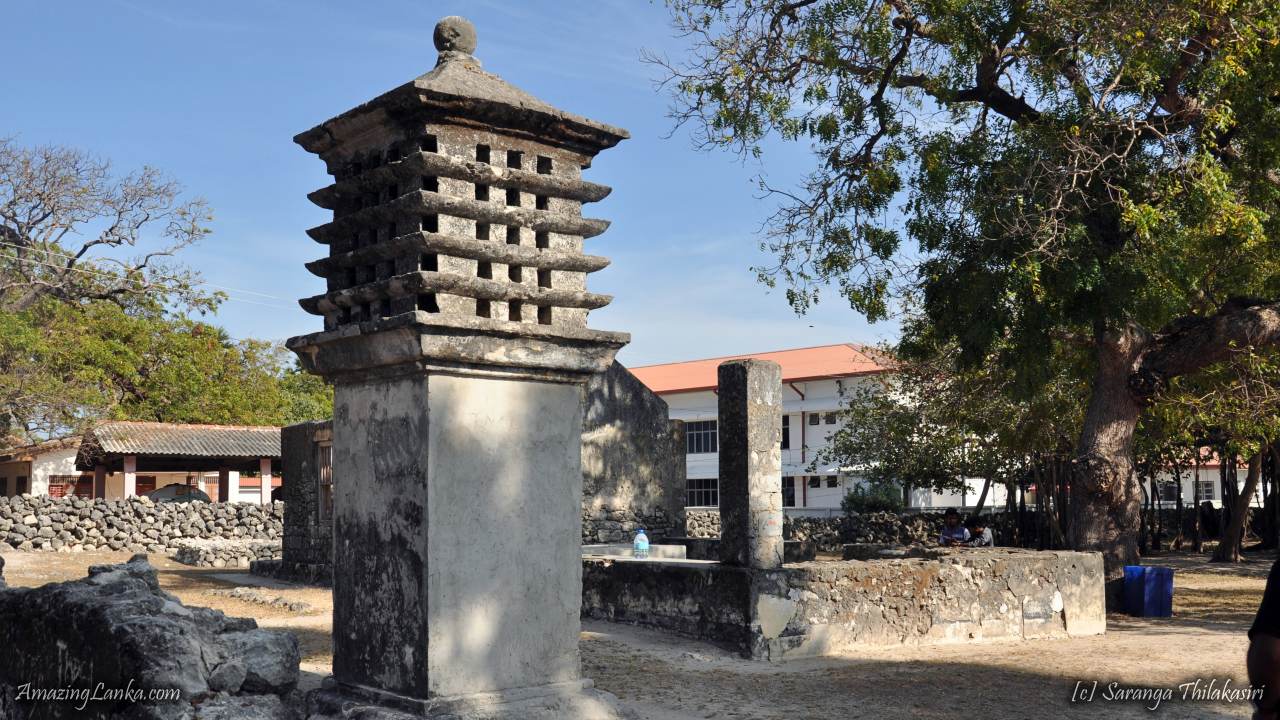Pigeons Nest – protected monument in Delft Island – By Arundathie Abeysinghe
Image Source : amazinglanka
 Located on the adjoining land of Delft Divisional Secretariat, the unique Pigeons Nest (Dovecote) is a historic landmark in *Delft Island. Considered as a special creation by the Dutch Colonials during the 17th – 18th centuries A.D., the Dutch had used *homing pigeons as an expedient to send messages between the adjoining islands, ships and the mainland.
Located on the adjoining land of Delft Divisional Secretariat, the unique Pigeons Nest (Dovecote) is a historic landmark in *Delft Island. Considered as a special creation by the Dutch Colonials during the 17th – 18th centuries A.D., the Dutch had used *homing pigeons as an expedient to send messages between the adjoining islands, ships and the mainland.
According to historical sources, during the Dutch Colonial Era, the Dutch who lived in Delft Island and surrounding islands have constructed the Pigeons Nest for the arrival, exit as well as for resting purposes of homing messenger pigeons. It is a one hour’s boat ride from Delft Island to the mainland. Hence, the pigeons had to fly over the Indian Ocean for over an hour to reach the mainland.
The square-shaped nest is constructed with limestone commonly found in Delft Island. Constructed on a square base with a side approximately 1.65 meters long, this nest has holes on all four sides with 15 per side. The four corners of the nest too have five cavities with total cavities in the nest to 80. The height of this nest is approximately four meters. It is well preserved.
The dove cage and the associated ruins were declared as an archaeologically protected monument by a government gazette notification on December 30, 2011.
- Chola – Known as Chola Dynasty, Tamil Empire in South India, it is one of the longest ruling dynasties of the world.
- Delft Island – Located approximately 30 kilometers off the west coast of the *Jaffna Peninsula, Delft Island (also known as Neduntivu or Neduntheeve meaning Long Island or Large Island) is the second largest island in Sri Lanka, an isolated island. History of Delft island spans over a thousand years, dating to the period of the *Chola Dynasty. The Island was initially occupied by the Chola Dynasty, the Portuguese and the Dutch in the 17th century and thereafter by the British. Abundant with colonial legacy, the Island is a stark contrast to the landscape of the mainland Sri Lanka, unique and extraordinary. Delft separates northern Sri Lanka from southern India. The Island is approximately eight kilometers in length and six kilometers wide. Delft Island is accessed via a navy-operated ferry which operates daily from Kurikkaduwan Jetty. Boarding preference is given to residents of the Island and the ferry is able to hold up to 100 passengers at a single time. A huge *baobab native to tropical Africa has been planted in Delft in the 16th century by Arab merchants.
- Homing pigeons (Colomba livia) – A type of domestic pigeon descended from the rock pigeon (also known as rock dove belonging to the family of Columba livia). According to zoologists, wild rock pigeons have an innate ability to find their way home from long distances. Pigeons are considered to have a good memory and have been used to fly from one location to the other. In the past, to send a message, a note was written on a piece of paper and tied to the pigeon’s leg.
- Jaffna – Capital city of the Northern Province of Sri Lanka and the administrative headquarters of Jaffna District, Jaffna is located on Jaffna Peninsula. In 1621, during the Portuguese Colonial Era, the Portuguese established Jaffna City as their colonial administrative center.
Baobab Tree – iconic landmark in Mannar – By Arundathie Abeysinghe
https://www.elanka.com.au/baobab-tree-iconic-landmark-in-mannar-by-arundathie-abeysinghe/
Queen’s Tower – alluring colonial legacy in Delft Island –By Arundathie Abeysinghe








